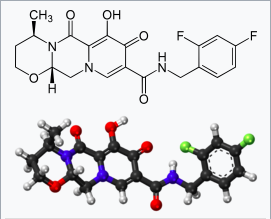Dolutegravir / rilpivirine
Editor-In-Chief: C. Michael Gibson, M.S., M.D. [1]; Associate Editor(s)-in-Chief: Sonya Gelfand
Disclaimer
WikiDoc MAKES NO GUARANTEE OF VALIDITY. WikiDoc is not a professional health care provider, nor is it a suitable replacement for a licensed healthcare provider. WikiDoc is intended to be an educational tool, not a tool for any form of healthcare delivery. The educational content on WikiDoc drug pages is based upon the FDA package insert, National Library of Medicine content and practice guidelines / consensus statements. WikiDoc does not promote the administration of any medication or device that is not consistent with its labeling. Please read our full disclaimer here.
Black Box Warning
|
Warning Title
See full prescribing information for complete Boxed Warning.
Condition Name: (Content)
|
Overview
Dolutegravir / rilpivirine is a Acetylcholine release inhibitor, Adrenergic receptor agonist that is FDA approved for the (type of indication of drug) of a list of indications, separated by commas.. There is a Black Box Warning for this drug as shown here. Common adverse reactions include a list of adverse reactions, separated by commas..
Adult Indications and Dosage
FDA-Labeled Indications and Dosage (Adult)
Condition 1
- Dosing Information
- (Dosage)
Condition 2
- Dosing Information
- (Dosage)
Off-Label Use and Dosage (Adult)
Guideline-Supported Use
Condition 1
- Developed by: (Organisation)
- Class of Recommendation: (Class) (Link)
- Strength of Evidence: (Category A/B/C) (Link)
- Dosing Information/Recommendation
- (Dosage)
Condition 2
- Developed by: (Organisation)
- Class of Recommendation: (Class) (Link)
- Strength of Evidence: (Category A/B/C) (Link)
- Dosing Information/Recommendation
- (Dosage)
Non–Guideline-Supported Use
Condition 1
- Dosing Information
- (Dosage)
Condition 2
- Dosing Information
- (Dosage)
Condition 3
- Dosing Information
- (Dosage)
Pediatric Indications and Dosage
FDA-Labeled Indications and Dosage (Pediatric)
Condition 1
- Dosing Information
- (Dosage)
Condition 2
- Dosing Information
- (Dosage)
Off-Label Use and Dosage (Pediatric)
Guideline-Supported Use
Condition 1
- Developed by: (Organisation)
- Class of Recommendation: (Class) (Link)
- Strength of Evidence: (Category A/B/C) (Link)
- Dosing Information/Recommendation
- (Dosage)
Condition 2
- Developed by: (Organisation)
- Class of Recommendation: (Class) (Link)
- Strength of Evidence: (Category A/B/C) (Link)
- Dosing Information/Recommendation
- (Dosage)
Non–Guideline-Supported Use
Condition 1
- Dosing Information
- (Dosage)
Condition 2
- Dosing Information
- (Dosage)
Condition 3
- Dosing Information
- (Dosage)
Contraindications
CONTRAINDICATIONS
Warnings
|
Warning Title
See full prescribing information for complete Boxed Warning.
Condition Name: (Content)
|
Conidition 1
(Description)
Conidition 2
(Description)
Conidition 3
(Description)
Adverse Reactions
Clinical Trials Experience
Central Nervous System
- (list/description of adverse reactions)
Cardiovascular
- (list/description of adverse reactions)
Respiratory
- (list/description of adverse reactions)
Gastrointestinal
- (list/description of adverse reactions)
Hypersensitive Reactions
- (list/description of adverse reactions)
Miscellaneous
- (list/description of adverse reactions)
Condition 2
Central Nervous System
- (list/description of adverse reactions)
Cardiovascular
- (list/description of adverse reactions)
Respiratory
- (list/description of adverse reactions)
Gastrointestinal
- (list/description of adverse reactions)
Hypersensitive Reactions
- (list/description of adverse reactions)
Miscellaneous
- (list/description of adverse reactions)
Postmarketing Experience
(Description)
Drug Interactions
- Drug 1
- Drug 2
- Drug 3
- Drug 4
- Drug 5
Drug 1
(Description)
Drug 2
(Description)
Drug 3
(Description)
Drug 4
(Description)
Drug 5
(Description)
Use in Specific Populations
Pregnancy
Pregnancy Category (FDA):
(Description)
Pregnancy Category (AUS):
There is no Australian Drug Evaluation Committee (ADEC) guidance on usage of Dolutegravir / rilpivirine in women who are pregnant.
Labor and Delivery
(Description)
Nursing Mothers
(Description)g
Pediatric Use
(Description)
Geriatic Use
(Description)
Gender
(Description)
Race
(Description)
Renal Impairment
(Description)
Hepatic Impairment
(Description)
Females of Reproductive Potential and Males
(Description)
Immunocompromised Patients
(Description)
Others
(Description)
Administration and Monitoring
Administration
(Oral/Intravenous/etc)
Monitoring
- Maintenance of virological suppression with HIV-1 RNA less than 50 copies/mL may indicate efficacy.
- Hepatotoxicity: Increased risk in those with underlying hepatitis B or C or marked elevations in transaminases prior to treatment.
- Adverse effects: In patients with severe renal impairment (CrCl less than 30 mL/min) or end-stage renal disease.
- Signs or symptoms of severe skin or hypersensitivity reactions.
IV Compatibility
There is limited information regarding the compatibility of Dolutegravir / rilpivirine and IV administrations.
Overdosage
- There is no known specific treatment for overdose with JULUCA. If overdose occurs, the patient should be monitored and standard supportive treatment applied as required, including monitoring of vital signs and ECG (QT interval) as well as observation of the clinical status of the patient. Administration of activated charcoal may be used to aid in removal of unabsorbed active substance. As both dolutegravir and rilpivirine are highly bound to plasma proteins, it is unlikely that either would be significantly removed by dialysis.
Pharmacology
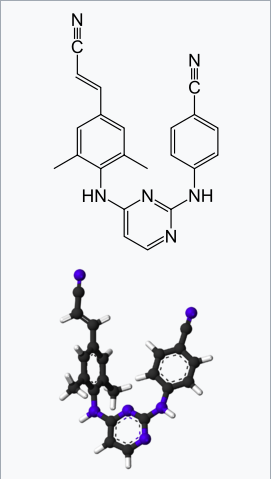
| |
Dolutegravir / rilpivirine
| |
| Systematic (IUPAC) name | |
| 4-{[4-({4-[(E)-2-cyanovinyl]-2,6-dimethylphenyl}amino)pyrimidin-2-yl]amino}benzonitrile | |
| Identifiers | |
| CAS number | |
| ATC code | J05 |
| PubChem | |
| Chemical data | |
| Formula | Template:OrganicBox atomTemplate:OrganicBox atomTemplate:OrganicBoxTemplate:OrganicBoxTemplate:OrganicBoxTemplate:OrganicBoxTemplate:OrganicBoxTemplate:OrganicBoxTemplate:OrganicBoxTemplate:OrganicBoxTemplate:OrganicBoxTemplate:OrganicBoxTemplate:OrganicBoxTemplate:OrganicBox atomTemplate:OrganicBoxTemplate:OrganicBoxTemplate:OrganicBoxTemplate:OrganicBoxTemplate:OrganicBoxTemplate:OrganicBoxTemplate:OrganicBoxTemplate:OrganicBoxTemplate:OrganicBox |
| Mol. mass | 366.42 g/mol |
| Pharmacokinetic data | |
| Bioavailability | ? |
| Metabolism | ? |
| Half life | 38 hours |
| Excretion | ? |
| Therapeutic considerations | |
| Licence data |
, |
| Pregnancy cat. |
B(US) |
| Legal status |
[[Prescription drug|Template:Unicode-only]](US) |
| Routes | Oral |
Mechanism of Action
- JULUCA is a fixed-dose combination of the HIV-1 antiretroviral agents, dolutegravir and rilpivirine.
Structure
- Dolutegravir:
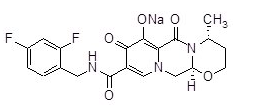
Rilpivirine:

Pharmacodynamics
Cardiac Electrophysiology
- The effect of JULUCA on the QT interval has not been studied.
- In a randomized, placebo-controlled, crossover trial, 42 healthy subjects received single-dose oral administration of placebo, dolutegravir 250-mg suspension (exposures approximately 3–fold of the 50-mg once-daily dose at steady state), and moxifloxacin 400 mg (active control) in random sequence. After baseline and placebo adjustment, the maximum mean QTc change based on Fridericia correction method (QTcF) for dolutegravir was 2.4 msec (1-sided 95% upper CI: 4.9 msec). Dolutegravir did not prolong the QTc interval over 24 hours post-dose.
- The effect of rilpivirine at the recommended dose of 25 mg once daily on the QTcF interval was evaluated in a randomized, placebo- and active- (moxifloxacin 400 mg once daily) controlled crossover study in 60 healthy adults, with 13 measurements over 24 hours at steady state. The maximum mean time-matched (95% upper confidence bound) differences in QTcF interval from placebo after baseline correction was 2.0 (5.0) milliseconds (i.e., below the threshold of clinical concern). When 75 mg and 300 mg once daily of rilpivirine (3 times and 12 times the recommended dosage in JULUCA, respectively) were studied in healthy adults, the maximum mean time-matched (95% upper confidence bound) differences in QTcF interval from placebo after baseline correction were 10.7 (15.3) and 23.3 (28.4) milliseconds, respectively. Steady-state administration of rilpivirine 75 mg once daily and 300 mg once daily resulted in a mean steady-state Cmax approximately 2.6-fold and 6.7-fold, respectively, higher than the mean Cmax observed with the recommended 25-mg once-daily dose of rilpivirine.
Effects on Renal Function
- The effect of dolutegravir on renal function was evaluated in an open-label, randomized, 3-arm, parallel, placebo-controlled trial in healthy subjects (n = 37) who received dolutegravir 50 mg once daily (n = 12), dolutegravir 50 mg twice daily (n = 13), or placebo once daily (n = 12) for 14 days. A decrease in creatinine clearance, as determined by 24-hour urine collection, was observed with both doses of dolutegravir after 14 days of treatment in subjects who received 50 mg once daily (9% decrease) and 50 mg twice daily (13% decrease). Neither dose of dolutegravir had a significant effect on the actual glomerular filtration rate (determined by the clearance of probe drug, iohexol) or effective renal plasma flow (determined by the clearance of probe drug, para-amino hippurate) compared with the placebo.
Pharmacokinetics
Absorption, Distribution, Metabolism, and Excretion
- The pharmacokinetic (PK) properties of the components of JULUCA are provided in TABLE 5. The multiple-dose pharmacokinetic parameters are provided in TABLE 6.
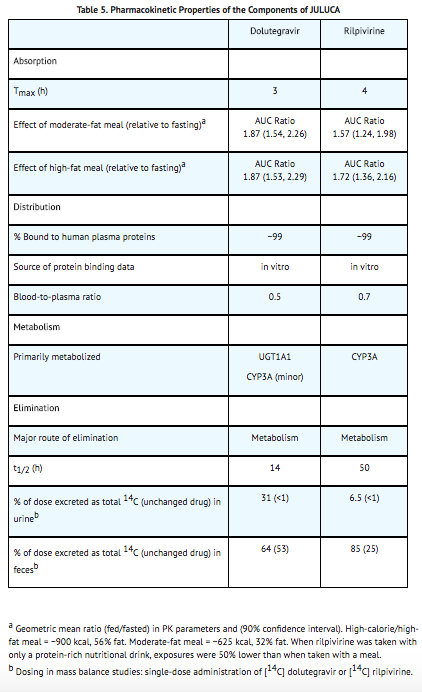
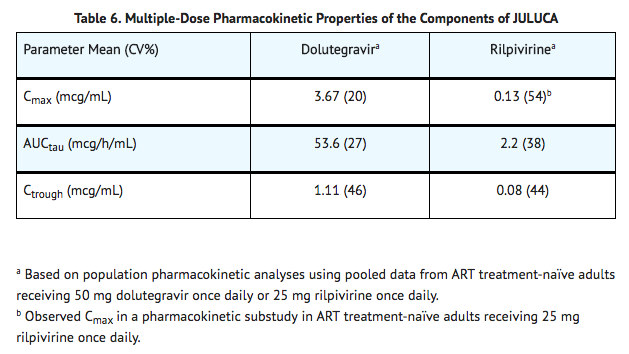
Specific Populations
- Pediatric Patients: The pharmacokinetics of dolutegravir plus rilpivirine has not been studied in pediatric subjects.
- Geriatric Patients: Population pharmacokinetic analyses from studies with the individual components indicated age had no clinically relevant effect on the pharmacokinetics of dolutegravir or rilpivirine. Pharmacokinetic data in subjects 65 years of age and older are limited.
- Patients with Renal Impairment: Population pharmacokinetic analyses indicated that mild and moderate renal impairment had no clinically relevant effect on the exposure of dolutegravir. Dolutegravir AUC, Cmax, and C24 were lower by 40%, 23%, and 43%, respectively, in subjects (n = 8) with severe renal impairment (creatinine clearance less than 30 mL/min) as compared with matched healthy controls. Dolutegravir has not been studied in patients requiring dialysis.
- Population pharmacokinetic analyses indicated that mild renal impairment had no clinically relevant effect on the exposure of rilpivirine. There is limited or no information regarding the pharmacokinetics of rilpivirine in patients with moderate or severe renal impairment, end-stage renal disease, or patients requiring dialysis.
- Patients with Hepatic Impairment: Dolutegravir exposures were similar in subjects (n = 8) with moderate hepatic impairment (Child-Pugh Score B) as compared with matched healthy controls. The effect of severe hepatic impairment (Child-Pugh Score C) on the pharmacokinetics of dolutegravir has not been studied.
- Rilpivirine exposure was 47% higher in subjects (n = 8) with mild hepatic impairment (Child-Pugh Score A) and 5% higher in subjects (n = 8) with moderate hepatic impairment (Child-Pugh Score B) compared with matched controls. The effect of severe hepatic impairment (Child-Pugh Score C) on the pharmacokinetics of rilpivirine has not been studied.
- Patients with HBV/HCV Co-infection: Population pharmacokinetic analyses indicated that hepatitis C virus co-infection had no clinically relevant effect on the exposure of dolutegravir or rilpivirine. Subjects with hepatitis B co-infection were excluded from studies with dolutegravir plus rilpivirine.
- Gender and Race: Population pharmacokinetic analyses from studies with the individual components revealed that gender and race had no clinically relevant effect on the pharmacokinetics of dolutegravir or rilpivirine.
Drug Interaction Studies
- Drug interaction trials were conducted with dolutegravir or rilpivirine as individual components and other drugs likely to be coadministered or commonly used as probes for pharmacokinetic interactions. In vitro, dolutegravir did not inhibit (IC50 greater than 50 microM) the following: CYP1A2, CYP2A6, CYP2B6, CYP2C8, CYP2C9, CYP2C19, CYP2D6, CYP3A, UGT1A1, UGT2B7, P-gp, BCRP, bile salt export pump (BSEP), organic anion transporter polypeptide (OATP)1B1, OATP1B3, OCT1, multidrug resistance protein (MRP)2, or MRP4. In vitro, dolutegravir did not induce CYP1A2, CYP2B6, or CYP3A4.
- In vitro, dolutegravir inhibited the renal OCT2 (IC50 = 1.93 microM) and MATE1 (IC50 = 6.34 microM). In vivo, dolutegravir inhibits tubular secretion of creatinine by inhibiting OCT2 and potentially MATE1. Dolutegravir may increase plasma concentrations of drugs eliminated via OCT2 or MATE1 such as dofetilide and metformin.
- In vitro, dolutegravir inhibited the basolateral renal transporters, organic anion transporter (OAT)1 (IC50 = 2.12 microM) and OAT3 (IC50 = 1.97 microM). However, in vivo, dolutegravir did not alter the plasma concentrations of tenofovir or para-amino hippurate, substrates of OAT1 and OAT3.
- Dolutegravir is metabolized by UGT1A1 with some contribution from CYP3A. Dolutegravir is also a substrate of UGT1A3, UGT1A9, BCRP, and P-gp in vitro. In vitro, dolutegravir was not a substrate of OATP1B1 or OATP1B3.
- Rilpivirine is primarily metabolized by CYP3A. Rilpivirine 25 mg once daily is not likely to have a clinically relevant effect on the exposure of medicinal products metabolized by CYP enzymes.
- Dosing recommendations as a result of established and other potentially significant drug-drug interactions with dolutegravir or rilpivirine are provided in TABLE 4.
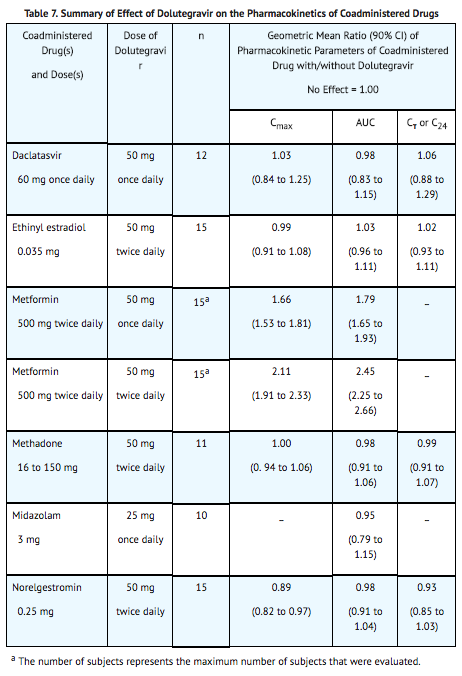



Microbiology
Mechanism of Action
- Dolutegravir inhibits HIV integrase by binding to the integrase active site and blocking the strand transfer step of retroviral deoxyribonucleic acid (DNA) integration which is essential for the HIV replication cycle. Strand transfer biochemical assays using purified HIV-1 integrase and pre-processed substrate DNA resulted in IC50 values of 2.7 nM and 12.6 nM.
- Rilpivirine is a diarylpyrimidine NNRTI of HIV-1 and inhibits HIV-1 replication by non-competitive inhibition of HIV-1 reverse transcriptase (RT). Rilpivirine does not inhibit the human cellular DNA polymerases α, β, and γ.
Antiviral Activity in Cell Culture
- Dolutegravir exhibited antiviral activity against laboratory strains of wild-type HIV-1 with mean EC50 values of 0.5 nM to 2.1 nM (0.21 to 0.85 ng per mL) in peripheral blood mononuclear cells (PBMCs) and MT-4 cells. Dolutegravir exhibited antiviral activity against 13 clinically diverse clade B isolates with a mean EC50 value of 0.52 nM in a viral integrase susceptibility assay using the integrase coding region from clinical isolates. Dolutegravir demonstrated antiviral activity in cell culture against a panel of HIV-1 clinical isolates (3 in each group of M [clades A, B, C, D, E, F, and G] and 3 in group O) with EC50 values ranging from 0.02 nM to 2.14 nM.
- Rilpivirine exhibited activity against laboratory strains of wild-type HIV-1 in an acutely infected T-cell line with a median EC50 value for HIV-1IIIB of 0.73 nM (0.27 ng per mL). Rilpivirine demonstrated antiviral activity against a broad panel of HIV-1 group M (clades A, B, C, D, F, G, H) primary isolates with EC50 values ranging from 0.07 nM to 1.01 nM (0.03 to 0.37 ng/mL) and was less active against group O primary isolates with EC50 values ranging from 2.88 to 8.45 nM (1.06 to 3.10 ng/mL).
Antiviral Activity in Combination with Other Antiviral Agents
- Neither dolutegravir nor rilpivirine were antagonistic to all tested anti-HIV agents or with each other when tested in combination.
Resistance
- Cell Culture: Dolutegravir-resistant viruses were selected in cell culture starting from different wild-type HIV‑1 strains and clades. Amino acid substitutions E92Q, G118R, S153F or Y, G193E, or R263K emerged in different passages and conferred decreased susceptibility to dolutegravir of up to 4-fold.
- Rilpivirine-resistant strains were selected in cell culture starting from wild-type HIV-1 of different origins and clades as well as NNRTI-resistant HIV-1. The frequently observed amino acid substitutions that emerged and conferred decreased phenotypic susceptibility to rilpivirine included: L100I; K101E; V106I and A; V108I; E138K and G, Q, R; V179F and I; Y181C and I; V189I; G190E; H221Y; F227C; and M230I and L.
- Virologically Suppressed Subjects: In the pooled SWORD-1 and SWORD-2 trials, 2 subjects in each treatment arm had confirmed virologic failure at any time through Week 48. The 2 subjects in the dolutegravir/rilpivirine arm had detectable resistance substitutions at rebound. One subject had the NNRTI-resistance-associated substitution K101K/E with no decreased susceptibility to rilpivirine (fold-change = 1.2) at Week 36, had no INSTI resistance-associated substitutions or decreased susceptibility to dolutegravir (fold-change less than 2), and had HIV-1 RNA less than 50 copies per mL at the withdrawal visit. The other subject had the dolutegravir resistance-associated substitution G193E at baseline (by exploratory HIV proviral DNA archive sequencing) and Week 24 (by conventional sequencing) without decreased susceptibility to dolutegravir (fold-change = 1.02) at Week 24. No resistance-associated substitutions were observed for the other 2 subjects in the comparative current antiretroviral regimen arms.
Cross-Resistance
- Dolutegravir: The susceptibility of dolutegravir was tested against 60 INSTI-resistant site-directed mutant HIV-1 viruses (28 with single substitutions and 32 with 2 or more substitutions). The single INSTI-resistance substitutions T66K, I151L, and S153Y conferred a greater than 2-fold decrease in dolutegravir susceptibility (range: 2.3-fold to 3.6-fold from reference). Combinations of multiple substitutions T66K/L74M; E92Q/N155H; G140C/Q148R; G140S/Q148H, R or K; Q148R/N155H; T97A/G140S/Q148, and substitutions at E138/G140/Q148 showed a greater than 2-fold decrease in dolutegravir susceptibility (range: 2.5-fold to 21-fold from reference).
- Rilpivirine: Considering all of the available cell culture and clinical data, any of the following amino acid substitutions, when present at baseline, are likely to decrease the antiviral activity of rilpivirine: K101E, K101P, E138A, E138G, E138K, E138R, E138Q, V179L, Y181C, Y181I, Y181V, Y188L, H221Y, F227C, M230I, or M230L.
- Cross-resistance in site-directed mutant virus has been observed among NNRTIs. The single NNRTI substitutions K101P, Y181I, and Y181V conferred 52 times, 15 times, and 12 times decreased susceptibility to rilpivirine, respectively. The combination of E138K and M184I showed 6.7 times reduced susceptibility to rilpivirine compared with 2.8 times for E138K alone. The K103N substitution did not show reduced susceptibility to rilpivirine by itself. However, the combination of K103N and L100I resulted in a 7 times reduced susceptibility to rilpivirine. In another study, the Y188L substitution resulted in a reduced susceptibility to rilpivirine of 9 times for clinical isolates and 6 times for site-directed mutants. Combinations of 2 or 3 NNRTI resistance-associated substitutions gave decreased susceptibility to rilpivirine (fold-change range: 3.7 to 554) in 38% and 66% of mutants, respectively.
- Cross-resistance to efavirenz, etravirine, and/or nevirapine is likely after virologic failure and development of rilpivirine resistance.
Nonclinical Toxicology
Carcinogenesis, Mutagenesis, Impairment of Fertility
Carcinogenesis
- Two-year carcinogenicity studies in mice and rats were conducted with dolutegravir. Mice were administered doses of up to 500 mg per kg and rats were administered doses of up to 50 mg per kg. In mice, no significant increases in the incidence of drug-related neoplasms were observed at the highest doses tested, resulting in dolutegravir AUC exposures approximately 20 times higher than those in humans at the recommended dose of 50 mg once daily. In rats, no increases in the incidence of drug-related neoplasms were observed at the highest dose tested, resulting in dolutegravir AUC exposures approximately 17 times higher than those in humans at the recommended dose of 50 mg once daily.
- Rilpivirine was evaluated for carcinogenic potential by oral gavage administration to mice and rats up to 104 weeks. Daily doses of 20, 60, and 160 mg per kg per day were administered to mice and doses of 40, 200, 500, and 1,500 mg per kg per day were administered to rats. In rats, there were no drug-related neoplasms. In mice, rilpivirine was positive for hepatocellular neoplasms in both males and females. The observed hepatocellular findings in mice may be rodent specific. At the lowest tested doses in the carcinogenicity studies, the systemic exposures (based on AUC) to rilpivirine were 21 (mice) and 3 (rats) times higher than those observed in humans at the recommended dose (25 mg once daily).
Mutagenesis
- Dolutegravir was not genotoxic in the bacterial reverse mutation assay, mouse lymphoma assay, or in the in vivo rodent micronucleus assay.
- Rilpivirine tested negative in the absence and presence of a metabolic activation system in the in vitro Ames reverse mutation assay and the in vitro clastogenicity mouse lymphoma assay. Rilpivirine did not induce chromosomal damage in the in vivo micronucleus test in mice.
Impairment of Fertility
- Dolutegravir did not affect male or female fertility in rats at doses associated with exposures approximately 33 times higher than the exposures in humans at the doses of 50 mg once daily.
- No human data on the effect of rilpivirine on fertility are available. In a study conducted in rats, there were no effects on mating or fertility with rilpivirine up to 400 mg per kg per day, a dose of rilpivirine that showed maternal toxicity. This dose is associated with an exposure that is approximately 40 times higher than the exposure in humans at the recommended dose of 25 mg once daily.
Clinical Studies
Clinical Trials in Adult Subjects Switching to JULUCA
- The efficacy of JULUCA is supported by data from 2 open-label, controlled trials [SWORD-1 (NCT02429791) and SWORD-2 (NCT02422797)] in virologically suppressed patients switching from their current antiretroviral regimen to dolutegravir plus rilpivirine.
- SWORD-1 and SWORD-2 are identical 148-week, Phase 3, randomized, multicenter, parallel-group, non-inferiority trials. A total of 1,024 adult HIV–1-infected subjects who were on a stable suppressive antiretroviral regimen (containing 2 NRTIs plus either an INSTI, an NNRTI, or a PI) for at least 6 months (HIV-1 RNA less than 50 copies per mL), with no history of treatment failure and no known substitutions associated with resistance to dolutegravir or rilpivirine received treatment in the trials. Subjects were randomized 1:1 to continue their current antiretroviral regimen or be switched to dolutegravir plus rilpivirine administered once daily. The primary efficacy endpoint for the SWORD trials was the proportion of subjects with plasma HIV-1 RNA less than 50 copies per mL at Week 48.
- At baseline, in the pooled analysis, the median age of subjects was 43 years (range: 21 to 79), 22% female, 20% non-white, 11% were CDC Class C (AIDS), and 11% had CD4+ cell count less than 350 cells per mm3; these characteristics were similar between treatment arms. In the pooled analysis, 54%, 26%, and 20% of subjects were receiving an NNRTI, PI, or INSTI (respectively) as their baseline third-treatment-agent class prior to randomization. This distribution was similar between treatment arms.
- The primary endpoint and other outcomes (including outcomes by key baseline covariates) for the pooled SWORD-1 and SWORD-2 trials are shown in TABLE 11. The virologic outcome results for SWORD-1 and SWORD-2 were similar to the pooled SWORD-1 and SWORD-2 virologic outcome results.

- Treatment differences were maintained across baseline characteristics including, CD4+ cell count, age, gender, race, and baseline third-treatment-agent class.
How Supplied
- Each JULUCA tablet contains 50 mg of dolutegravir and 25 mg of rilpivirine, and is a pink, oval, film-coated, biconvex tablet debossed with “SV J3T” on one side.
- Bottle of 30 tablets with child-resistant closure (contains a desiccant) NDC 49702-242-13.
Storage
- Store and dispense in the original package, protect from moisture, and keep the bottle tightly closed. Do not remove desiccant.
- Store at 20°C to 25°C (68°F to 77°F); excursions permitted 15°C to 30°C (59°F to 86°F).
Images
Drug Images
{{#ask: Page Name::Dolutegravir / rilpivirine |?Pill Name |?Drug Name |?Pill Ingred |?Pill Imprint |?Pill Dosage |?Pill Color |?Pill Shape |?Pill Size (mm) |?Pill Scoring |?NDC |?Drug Author |format=template |template=DrugPageImages |mainlabel=- |sort=Pill Name }}
Package and Label Display Panel
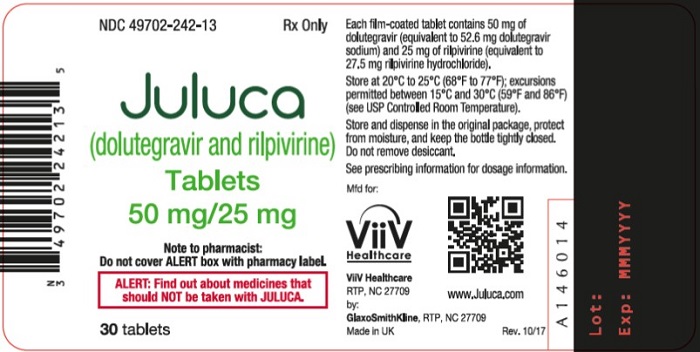
{{#ask: Label Page::Dolutegravir / rilpivirine |?Label Name |format=template |template=DrugLabelImages |mainlabel=- |sort=Label Page }}
Patient Counseling Information
- Advise the patient to read the FDA-approved patient labeling.
Severe Skin and Hypersensitivity Reactions
- Advise patients to immediately contact their healthcare provider if they develop a rash. Instruct patients to immediately stop taking JULUCA and seek medical attention if they develop a rash associated with any of the following symptoms, as it may be a sign of a more serious reaction such as DRESS severe hypersensitivity: fever; generally ill feeling; extreme tiredness; muscle or joint aches; blisters or peeling of the skin; oral blisters or lesions; eye inflammation; facial swelling; swelling of the eyes, lips, tongue, or mouth; breathing difficulty; and/or signs and symptoms of liver problems (e.g., yellowing of the skin or whites of the eyes; dark or tea-colored urine; pale-colored stools or bowel movements; nausea; vomiting; loss of appetite; or pain, aching, or sensitivity on the right side below the ribs). Advise patients that if hypersensitivity occurs, they will be closely monitored, laboratory tests will be ordered, and appropriate therapy will be initiated.
Hepatotoxicity
- Inform patients that hepatotoxicity has been reported with rilpivirine and dolutegravir, components of JULUCA. Inform patients that monitoring for hepatotoxicity is recommended.
Depressive Disorders
- Inform patients that depressive disorders (depressed mood, depression, dysphoria, major depression, mood altered, negative thoughts, suicide attempt, suicidal ideation) have been reported with the components of JULUCA. Advise patients to seek immediate medical evaluation if they experience depressive symptoms.
Drug Interactions
- JULUCA may interact with many drugs; therefore, advise patients to report to their healthcare provider the use of any other prescription or nonprescription medication or herbal products including St. John’s wort.
Administration Instruction
- Inform patients that it is important to take JULUCA once daily on a regular dosing schedule with a meal and to avoid missing doses as it can result in development of resistance. Instruct patients that if they miss a dose of JULUCA, to take it as soon as they remember with a meal. Advise patients not to double their next dose. Advise the patient a protein drink alone does not replace a meal.
Pregnancy Registry
- Inform patients that there is an antiretroviral pregnancy registry to monitor fetal outcomes of pregnant women exposed to JULUCA.
Lactation
- Instruct women with HIV-1 infection not to breastfeed because HIV-1 can be passed to the baby in the breast milk.
Storage
- Instruct patients to store JULUCA in the original bottle to protect from moisture and keep the bottle tightly closed. Do not remove desiccant.
- JULUCA, TIVICAY, and TRIUMEQ are trademarks owned by or licensed to the ViiV Healthcare group of companies.
- The other brand listed is a trademark owned by or licensed to its respective owner and is not a trademark owned by or licensed to the ViiV Healthcare group of companies. The maker of this brand is not affiliated with and does not endorse the ViiV Healthcare group of companies or its products.

Precautions with Alcohol
Alcohol-Dolutegravir / rilpivirine interaction has not been established. Talk to your doctor regarding the effects of taking alcohol with this medication.
Brand Names
- Juluca
Look-Alike Drug Names
There is limited information regarding Dolutegravir / rilpivirine Look-Alike Drug Names in the drug label.
Drug Shortage Status
Drug Shortage
Price
References
The contents of this FDA label are provided by the National Library of Medicine.
- ↑ "Tivicay® (dolutegravir) Tablets for Oral Use. Full Prescribing Information" (PDF). ViiV Healthcare, 2013. Archived from the original (PDF) on 3 January 2014. Retrieved 9 February 2014.
